Longer trains can be a blessing or a curse, depending on where you sit. Certainly when stuck at a blocked crossing, one can only see the negatives. But what does a more wholistic assessment of longer trains reveal? Does the frustration outweigh the benefits, or are longer trains a key to solving some of the nation’s and the world’s largest problems?
The three lenses to answer this problem will be safety, cost, and climate impact. These may not seem substantial, but each offers a rich and deep level of analysis. The bottom line may be unexpected. Before getting to this analysis, some context is important.
Freight rail is part of the vital transportation network in the United States that allows for modern life. While trains can strike some people as a 19th or 20th century mode of transport, the 21st century rail industry is nothing short of a modern marvel.
The freight rail industry has a few oddities relative to other major American industries. It stands out as an efficient and safe industry that is economically deregulated, making economy-defining decisions without significant government oversight or enforcement around rates and other issues. Additionally, it is privately funded, somehow able to compete with publicly funded roads and efficient, deep-pocketed fossil fuel pipelines to transport hazardous materials in addition to payloads of raw resources and commercial goods. Finally, it is as technologically advanced as any other industry, utilizing a vast interconnected network of satellites, software, drones, and continuously monitoring track technology. Whether inside the locomotive or 20,000 miles above the earth, technology is integrated into the DNA of the modern train.
Safety
Train Accidents
To assess rail safety within the context of train length, we must ensure we begin with available data. According to the Government Accountability Office (GAO), “Freight Trains Are Getting Longer.” We can start with lining up train accident rates on a timeline. Importantly, even the GAO admits in the same title alongside the statement concluding train length has grown that, “Additional Information Is Needed to Assess Their Impact.”
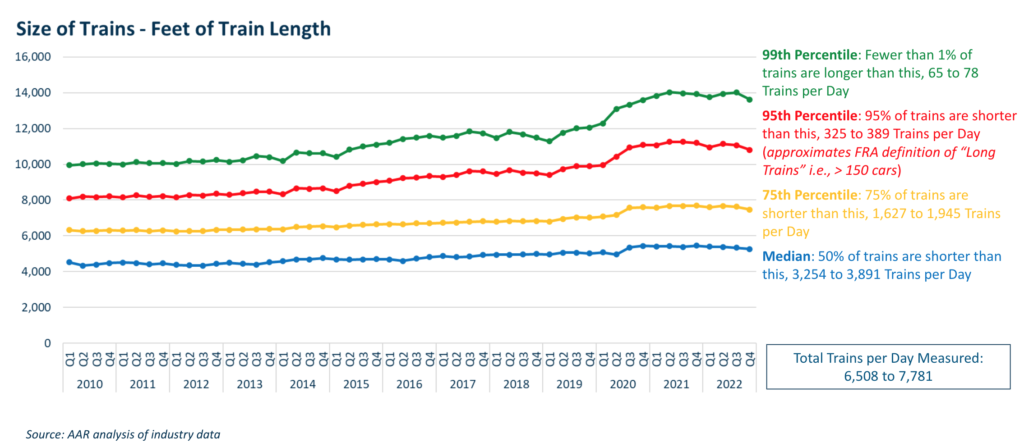
Consistent with the GAO, the Association of American Railroads also shows train length growing. Yet data from the Federal Railroad Administration (FRA) indicates that during this same period, there has been a downward trend in train accidents. These are the type of accidents reported through FRA Form 54 and do not necessarily include incidents taking place on stationary trains, in rail yards, or all crossing incidents. Beginning with train accidents, there is not an obvious safety concern.
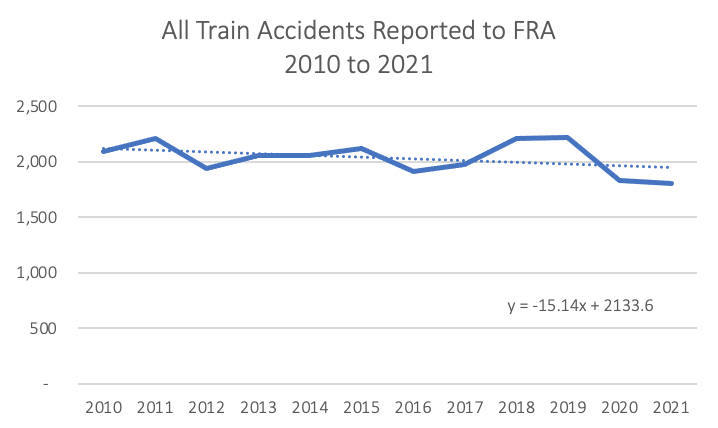
While correlation does not imply causation, a lack of correlation is strong evidence that a hypothesis is not supported. In this case, the hypothesis that longer trains are inherently less safe is contradicted by train length increasing over the same period that train accident numbers are decreasing.
Before departing Form 54 train accident data, we can also seek train length to assess the potential correlation between longer trains and accidents another way. By adding total cars for each report (i.e., the sum of loaded freight, unloaded freight, loaded passenger, unloaded passenger, and cabooses) we can filter the data by number of cars. When we do this, we find that out of approximately 24,400 reported train accidents from 2010 to 2021, only around 4,400 (or 18 percent) included total train of 100 or more cars. We can assume, then, that more than 80 percent of trains involved in accidents from 2010 to 2021 were less than a mile long.
Plotting the train accidents by year with train car totals reveals an interesting visualization. Each string below represents years from 2010 through 2021 (left to right). The dots align with the left to represent total train cars, and every data point reflects a reported accident. While we can see the dots are trending higher as time goes on – consistent with known train length increases over time – the density of train accidents remains concentrated in the lower train lengths as measured by train car counts. For longer trains to correlate with more accidents, we would expect to see greater concentration of dots toward the top of each string, rather than tightly packed toward the lower car counts at the bottom of each string. There are more accidents when total car counts are higher, but this offers an unclear picture and says nothing yet about causation. [Note: because every dot represents an accident, definitive safety conclusions cannot be drawn from this chart because it does not display long or short trains that did not experience an accident. This chart merely displays of the set of those trains that did have accidents, the distribution of train cars.]
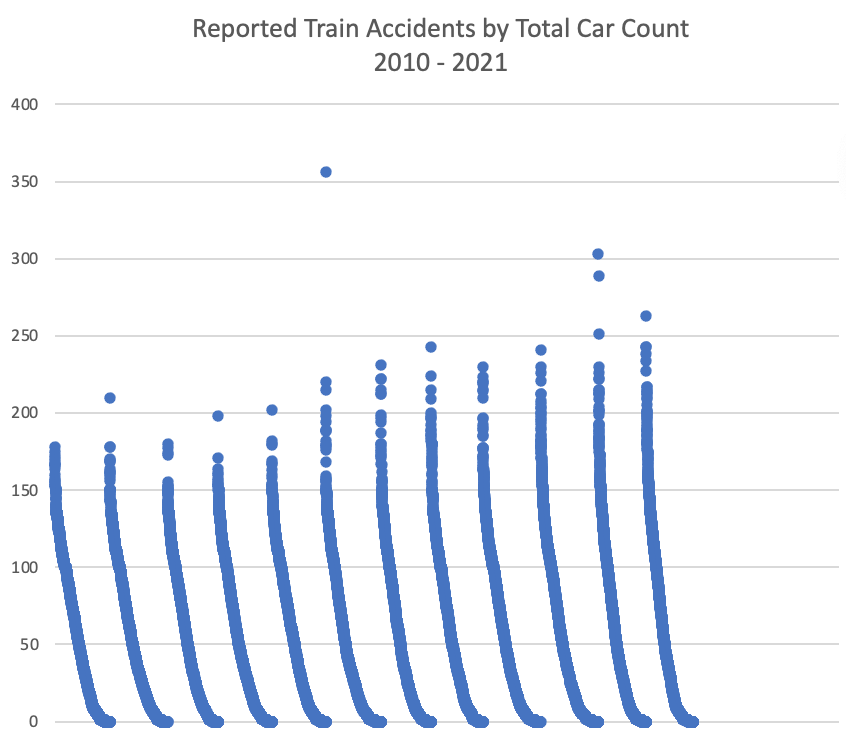
The available data up to this point does not provide strong evidence that increasing train lengths correlate with safety concerns as measured by train accidents. There may even be weak evidence to the contrary, that accidents continue to decline as trains increase in length. That may suggest that running fewer trains decreases the statistical incidence of train accidents. It does not tell us whether other kinds of safety issue arise, even if it is true that lowering the total number of trains reduces train accident numbers.
Crossing Accidents and Blocked Crossings
Not every rail issue is a train accident happening on a moving train on mainline track. Other issues occur on siding, rail yards, and even stationary trains. Of particular concern are crossings, where drivers on public roadways interact with trains a highway grade crossings. Crossing incidents such as train-truck collisions can be devastating and are critical to address.
Longer trains may contribute in some ways, but not materially. When a truck driver decides to pass over a crossing, he does not know whether the train is 50 cars or 100 cars. What is relevant to him is the distance of the locomotive, not how many cars are lined up behind. And when an engineer and conductor approach a crossing, the relevant factors are the distance between them and the crossing. The length of the train is relevant to how long the train will take to complete its crossing, but as soon as the locomotive enters the crossing it is no longer relevant to crossing safety whether the train is long or short. In other words, vehicles cannot move through the intersection once the train has entered it, so only accidents involving a vehicle driving directly into the side of a train would be relevant, and those could not be correlated to the train’s length.
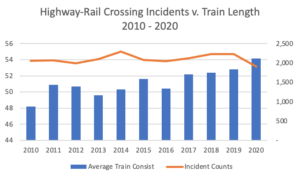
Engineers and conductors do need to be keenly aware of their payload and train length and weight. These are relevant to the distance it will take a train to stop and are relevant for calculating the speed, distance, and time before entering an intersection/crossing. Longer and heavier trains with more momentum will take longer to stop and more data is needed to assess the safety risks associated and the incidence of making emergency stops.
Once a train has entered a crossing and stopped, new risks arise. In particular, longer trains are more likely to block crossings, as even if the locomotive has moved well past the crossing, the numerous cars behind it may linger. As mentioned, vehicles are unlikely to ram into the side of a train – although some do, and the ultimate liability would rest with the driver not the train (from 2010-2020, a total of 4,326 incidents are recorded as a train struck BY a highway user, while the same period records 19,608 incidents recorded that a train struck a highway user).
The primary risk is to pedestrians who (unlawfully) cross the track or climb between rail cars to pass through the stalled train. Many children, teens, and adults (including many under the influence of substances) make this decision and harm themselves. The risks can include small scrapes and bruises, falling or becoming pinned by the industrial equipment, or at worst being in between cars or near the wheels as the train begins to move. These obviously range from somewhat innocuous to lethal, and these risks are not present when a train is moving through a crossing, but seemingly unique to trains that stop and block crossings.
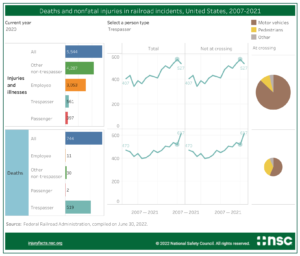
Trespasser injury, illness, and fatalities have all been rising in the last decade. This seems like an obvious correlation with longer trains (although not causation), but these do not seem to be taking place at crossings. It may call into question whether longer trains give trespassers more potential to interact with a train – such as a long train stopped and a trespasser passing through it at a point other than a crossing/intersection. If the train is sufficiently long that a pedestrian cannot walk around it, the train length may be a factor in their decision to pass through it. This is not established through data, however.
Sticking to the data, there is some evidence that longer trains result in fewer casualties at crossings. For instance, for all highway-rail incidents from 2010 to 2020, there were 12,933 casualties (both injuries and fatalities). For trains over 100 cars, which represent 19.2 percent of all trains involved in accidents in this range, a smaller proportion of fatalities occurred at 2,195 or 16.9 percent. The trains of 100 cars and shorter represent 80.8 percent of accidents while representing 83.1 percent of the casualties.
A secondary risk and concern are blocked crossings thwarting emergency response vehicles from passing through a crossing. If a mile-long train is blocking a crossing, an ambulance responding to a call or with a patient onboard will either wait at the crossing for an indeterminate period of time until the train clears or is split or seek a less efficient route to their destination. This intuitive concern is yet unestablished in data.
The FRA is currently collecting submissions from the public and from law enforcement officials through a blocked crossing incident reporter, but few safeguards exist to prevent false information, low quality submissions, repeated submissions, or a combination or confluence of these and other data quality concerns. When this data is known, it should be incorporated into a wholistic view.
Slips, Trips, Falls, and Fatigue
Long trains mean more train cars that may have more bad wheel bearings or trip more sensors. Whether they have these problems in reality is unclear, but the potentiality for them is unquestionably increased in proportion to train length. If and when these issues do arise, it means the engineer and/or conductor may be responsible for stopping the train and walking its length to inspect or address an issue. The longer the train, the longer the round trip back to the locomotive, which again increases the potential for issues. In particular are slips, trips, falls, and fatigue.
These can interact with a secondary rail issue of train crew size. One alternative is roving or ground-based conductors, who can arrive on scene or help reduce engineer/conductor fatigue from the locomotive. As it stands, a two mile train would require an engineer to walk a four-mile roundtrip if the relevant issue where at the back of the train. This maximal distance is incredibly rare and unlikely. In part, because even with the general train length increasing, still 95 percent of Class I trains are less than 11,000 feet (2.08 miles), with the median length around 5,300 feet (one mile). The likelihood of an issue requiring the engineer to walk from head locomotive to caboose or final car is also highly unlikely.
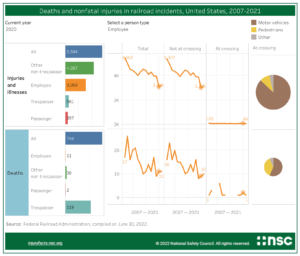
It is also the case that over the same period that train length has grown, railroad employee safety has improved, with the number of injuries, illnesses, and death declining significantly. Railroads also have comparable or better safety record for death, injury, and illness relative to similar and a broad cross section of industry across most metrics, according to data from the Bureau of Labor Statistics. One relevant and concerning metric where railroads outpace the transportation sector broadly and all industry is in sprains and fractures. The data here is railroad industry-wide and would include everyone from inspectors to fabricators and people in trains, rail yards, and elsewhere, making a definitive correlation with train length very difficult to surmise. It is also the case that this higher rate of sprains and fractures appears to be a natural consequence of the railroad industry, not that it increases with train length. Nevertheless, as train length increases and more walking is required, this is a natural statistic to explore in greater depth.
Intuition
When the data is insufficient, we can also contemplate based on intuition. The most basic intuition is that by running longer trains, there are fewer trains needed. By reducing the number of trains, there is a natural reduction in the probability of an incident.
Other intuition tells us that while fewer incidents may arise from running fewer trains, the lower number of incidents could be more severe with longer trains, as there are more train cars or tanks in the equation. This could apply to derailment and also to trains lingering longer in intersections and crossings. Longer trains also mean greater weight and momentum, which translates into longer time needed to slow and stop. This would all but guarantee an incident if the engineer or conductor visually identifies an issue on the track, even at the edge of their vision, because the train could not stop in time.
Other issues may be that a long train leads to worker fatigue. An engineer or conductor walking from the head locomotive to diagnose or fix an issue may mean three to four miles in round trip walking. Even with teams, this could threaten a radio going out of range or incident or injury leading to the worker being far away from aid.
Where we must return is the data. These intuitive exercises are critically important, and they fill much of the dialogue between unions and carriers during collective bargaining. The problem is that neither side has robust, reliable, and high-quality data to support the case that any of these eventualities are occurring at all, much less that they are systemic rather than anecdotal.
The intuitive analysis ends up with many points counteracting one another, leaving only a few possible concerns measured up against volumes of data that the general safety trend has been fewer incidents even while train length has grown. Certainly this cannot establish a causal relationship that longer trains are improving safety, but it is enough to establish a rebuttable presumption that longer trains are safe.
Hazardous Material
While hazardous material will be addressed more fully in our third policy blog of this series, it is worth noting hazmat as a safety issue here. Since 2000, fewer than one percent of train accidents have identified a release of hazardous materials. Narrowing to the past decade, while train length has been notably increasing, the same <one percent figure holds. The past 10 years have seen the accident rate for hazmat fall by 55 percent, even while the general trend in train accidents has seen a roughly 10 percent decline in all train accidents. At this time, data is not sufficient to establish reason for concern that train length and hazardous material releases are positively correlated.
Unless or until more data is known, train length is not a stand-along safety issue. With that said, trends may shift and change as other factors change and we will look to the data as they do.
Stay tuned for the next two blogs in this series: Costs and Climate Impact.
Written by Benjamin Dierker, Executive Director
The Alliance for Innovation and Infrastructure (Aii) is an independent, national research and educational organization. An innovative think tank, Aii explores the intersection of economics, law, and public policy in the areas of climate, damage prevention, energy, infrastructure, innovation, technology, and transportation.